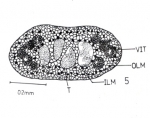NEIHPID
North-East India Helminth Parasite Information Database
Recently added
Parasites
Molecular Data
Lytocestus attenuatus (Tandon, Chakravarty and Das Tandon, Chakravarty and Das)
Taxonomy
Platyhelminthes »
CESTODA »
Caryophyllidea »
Lytocestidae Wardle et McLeod, 1952 »
Lytocestinae Satpute et Agarwal, 1980 »
Lytocestus Cohn, 1908 »
Lytocestus attenuatus, Tandon, Chakravarty and Das 2005
Host
Clarias (batrachus)(L.)
Habitat
Intestine
Locality
Guwahati (Assam), Shella (Meghalaya)
Description
Body thin, slender, elongated, flattened, posterior end broader than anterior, 11.88 -35.44 mm in length, 0.66 -1.18 mm in maximum breadth at level of cirrus sac; body proper divided into outer cortex and inner medulla by two layers of longitudinal muscles. Scolex smooth, undifferentiated, unarmed, with bluntly rounded extremity, followed by long narrow neck. Testes ovoid, 155-398 in number, longer than vitelline follicles, occupying medullary region, extending from just posterior to anterior vitelline follicles caudad up to cirrus sac; cirrus sac medullary, enclosing thin winding ejaculatory duct, opening separately from and anterior to utero-vaginal pore. Ovary bilobed, follicular, inverted A-shaped, lobes extending to posterior level of Mehlis’ gland and joined to each other by ovarian isthmus, ovarian lobes cortical, isthmus medullary; Mehlis’ gland well developed, behind ovarian isthmus; uterus glandular, extending from behind Mehlis’ gland anteriad beyond lateral horns of ovary and up to cirrus pouch; vagina distinct, straight or slightly convoluted, joining terminal end of uterus to open at utero-vaginal pore. Vitelline follicles ovoid, arranged in two rows lateral to testes, extending from just anterior to testes up to cirrus sac. Excretory pore terminal. Eggs 0.04 -0.06 x 0.02 -0.03 mm in size, smooth, operculate.Â
Remarks
In sharing the characters such as shape of the body (which is thin, slender and elongated) and undifferentiated scolex, the present form comes close to L. longicollis, L. parvulus, L. filiformis, L. fossilis and L. javanicus. However, it differs from each of them in certain characters: from L. longicollis in having a still longer neck and previtellarial region and in not possessing a receptaculum seminis; from L. parvulus in lacking a linear arrangement of vitelline follicles in five rows; from L. fossilis in the absence of post-ovarian vitelline follicles; and from L. filiformis in having oval and large vitelline follicles as compared to the small and globular ones occurring in the latter species. L. javanicus differs from the present form in not having a long neck. The present form also differs from the type species in characters such as the shape and the size of the body and size of the egg. In lacking a prominent holdfast, which is a distinct feature of L. indicus and L. birmanicus, the present form can be distinguished from these species. It also stands apart from L. clariae, in having distantly apart genital apertures and smooth-surfaced eggs.
Considering all the above differences, it is proposed to assign to the present form the rank of a new species.
Specific diagnosisBody filliform; scolex undifferentiated; long, slender neck; ovary inverted A-shaped; testes medullary, vitellaria in two fields lateral to testes; eggs smooth, operculate.
Etymyology
Named after the shape of the body.
Helminthological collections record
NEHU/Z - CF/3
Specimen Type
Holotype; IV/ERS 292; Paratype: IV/ERS 293; T. S. series IV/ERS 294



.jpg)
